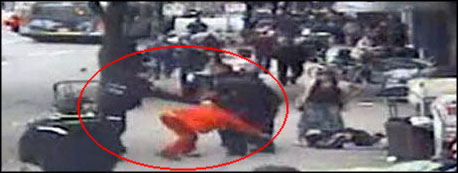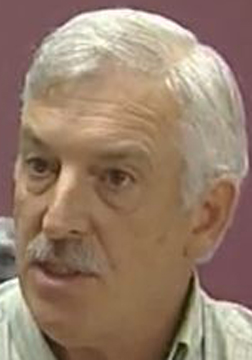VPD Const. Taylor Robinson
charged with assault
but the OPCC gang
have questions to answer
Where was B.C.’s police ‘watchdog’ for six weeks
after the Vancouver police assault on a disabled woman?
Dec. 8, 2010
The woman in red is Sandy Davidsen, who’s being shoved to the ground
by Vancouver police Constable Taylor Robinson.
Click on the photo to see the video.
B.C.’s corrupt police complaint commissioner Stan T. Lowe and his
equally corrupt deputy police complaint commissioner Bruce M. Brown
most likely colluded in a Vancouver police cover-up.
Despite video evidence it took New Westminster police and Crown attorneys well over three months to lay an assault charge against Vancouver police constable Taylor Robinson, who was caught shoving Sandy Davidsen, a disabled woman, to the ground for no apparent reason.
The investigation didn’t even begin until nearly seven weeks after the assault. Where was B.C.’s Office of the Police Complaint Commissioner during that time — if not helping Vancouver cops with a cover-up?
The assault took place June 9. But it didn’t become public knowledge until July 22, when the B.C. Civil Liberties Association released surveillance video and the media picked up the story. Then, and only then, the VPD and OPCC each publicly acknowledged that they learned about the assault soon after it happened. A few days later an investigation by an outside police force was ordered and Robinson was transferred to other duties.
There’s no credible indication that any investigation took place before the week of July 22.
Up to then Robinson was still walking a beat in the poverty-stricken neighbourhood where the assault took place and where there was a good chance he would encounter his victim again.
Vancouver police say they have a policy of requesting an outside police force to investigate allegations of serious misconduct among VPD officers. This incident sure is serious. It involves a gratuitous assault, an assault against a handicapped woman, and an assault that happened in a neighbourhood where police credibility was already severely strained.
Serious indeed, but an outside force wasn’t called in until after July 22, when the BCCLA released the video to the media.
Vancouver police also say they have a policy of notifying the public promptly when an officer is investigated for a serious incident. But no notification was given until July 22.
The provincial Police Act requires cops to inform the OPCC when a police officer is being investigated. So the VPD should have informed the OPCC on June 9 or very soon after.
The OPCC says it did learn about the incident promptly. So why didn’t the OPCC order an outside investigation — or even an internal investigation — well before July 22?
Why didn’t the OPCC make an announcement before then?
There’s very little room for any but two possible conclusions: The OPCC learned about the assault soon after it happened but colluded in a Vancouver police cover-up. Or Vancouver police failed to inform the OPCC, as required by law, but the OPCC claimed otherwise to protect their cop buddies.
No one in politics cares and the OPCC answers to nobody — not the provincial Ombudsperson nor anyone else. But someone in the media should demand answers from Stan Lowe or Bruce Brown.
This assault not only reflects horribly on Vancouver police, but shows the OPCC’s true colours. Stan Lowe and his crew of ex-cops excuse, rationalize or cover up misconduct and criminal actions by police, except for some of the cases that get timely publicity, support from an influential organization or caught on video. This July 22 before-and-after contrast shows a typical example of how the OPCC operates.
Read more about the Stan Lowe/Bruce Brown/Rollie Woods/OPCC cover-up
of VPD constable Taylor Robinson’s assault on a disabled woman
Read more about B.C.’s Office of the Police Complaint Commissioner
Read more news and comment about police accountability in B.C.



